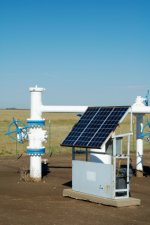|
|
Solar Powered Telemetry << Go Back
|
|
 What is Solar Powered Telemetry?
What is Solar Powered Telemetry?
Telemetry is the science and technology of automatic measurement and
transmission of data by wire, radio, or other means from remote sources,
as from space vehicles, to receiving stations for recording and analysis.
Solar Powered Telemetry Equipment is widely used in the applications such as
water, wastewater management, river and lake level monitoring, defense, navigation,
weather monitoring, fisheries and wildlife research.
A solar-powered telemetry system is usually made up of three different subsystems:
solar power system, telemetry Equipment system and communication system.
Solar Power System

The solar power system consists of solar modules, a solar charge controller, rechargeable
deep-cycle battery, power converter or inverter and a weather-proof outdoor enclosure. This system
is used to collect solar power and store electrical power, and
convert the stored power into the correct voltage to operate the telemetry equipment.
Telemetry Equipment
The telemetry system may have different configurations depending
on the scope and needs of the application. In general,
it basically breaks down into three areas:
sensors, signal conditioning and MCU. The telemetry system is responsible for
the collection and reporting of system status, plus process and environmental data such as temperature, level, pressure,
humidity and water quality.
Communication System
The communication system employs different technologies and components
according to the communication needs of the system and the
base or control center. The direct communication with the control center is
usually achieved by high-power radio, cellular or satellite modules dedicatedly designed for
long distance transmission.
|
Applications for Solar Powered Telemetry Systems
- Water / Wastewater Management & Monitoring
- Oil and Gas Industry
- Auto Racing
- Agriculture & Farming
- Energy Monitoring
- Security & Law Enforcement
- Fish & Wildlife Management
- Defense & Space Communication Systems
|
|
|
|



